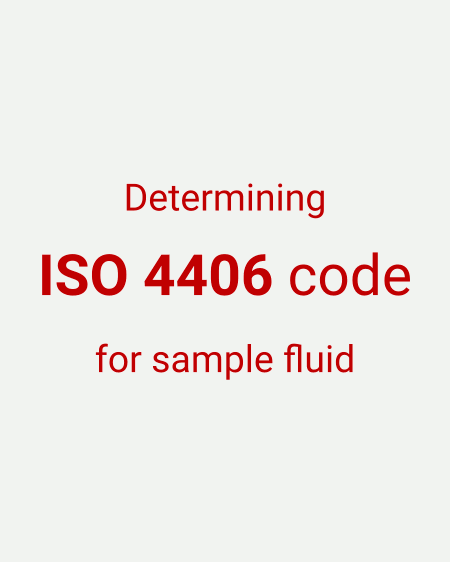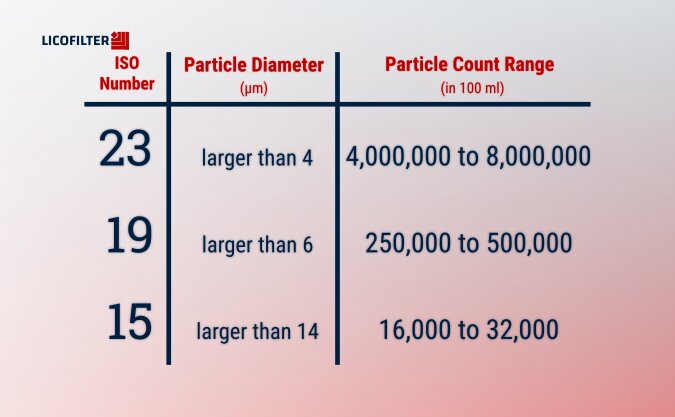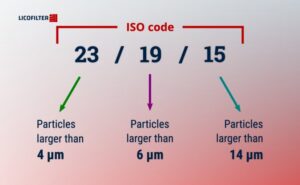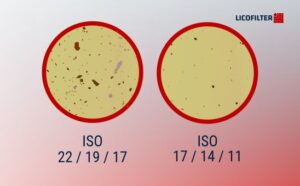This is the fifth part of a ten-part series on Hydraulics and Filtration, a general guide on hydraulic filtration systems. This part will review the topic of hydraulic fluid cleanliness and the ISO 4406 standard, which is used to define and measure fluid contamination levels.
The hydraulic fluid, a fundamental part of every hydraulic system, is responsible for force transmission. Use of hydraulic fluid makes it possible to conveniently change the amount and direction of force by simply adjusting the flow, pressure or direction of the fluid, thus eliminating the need for many mechanical parts or processes.
In order to achieve an acceptable system efficiency and durability, the hydraulic fluid used should be in good condition. All the aforementioned types of contaminants, namely solid particles, water and air, can deteriorate fluid condition. Therefore, it is crucial to attempt to protect hydraulic systems from the damaging effects of contaminants, as much as possible.
In the first step, the type and amount of contaminants in the fluid should be determined. Solid particles are the most important of these contaminants. As the presence of contaminants in the fluid is inevitable, the International Standards Organization has published ISO 4406 for a standardized measurement of these contaminants. ISO 4406 provides a common protocol for determining fluid contamination level in terms of solid particle content.
In this chapter, we will review briefly the ISO 4406 standard and show how to determine the cleanliness code (also known as ISO-code) of a given fluid using a chart provided in the standard document.
ISO 4406
Based on this standard, a fluid is given a three-part code based on the severity of its contamination. Each part of the ISO 4406 code is based on a predefined size range of particles:
- Particles larger than 4μm
- Particles larger than 6μm
- Particles larger than 14μm
For each range, the number of particles in the fluid are counted, and the final number is extracted from table below. The result will be three numbers, each of which indicate the contamination level regarding a specific particle size range.
ISO 4406 standard table
| Range | Minimum Number of Particles (in 100ml) |
Maximum Number of Particles (in 100ml) |
| 28 | 130,000,000 | 250,000,000 |
| 27 | 64,000,000 | 130,000,000 |
| 26 | 32,000,000 | 64,000,000 |
| 25 | 16,000,000 | 32,000,000 |
| 24 | 8,000,000 | 16,000,000 |
| 23 | 4,000,000 | 8,000,000 |
| 22 | 2,000,000 | 4,000,000 |
| 21 | 1,000,000 | 2,000,000 |
| 20 | 500,000 | 1,000,000 |
| 19 | 250,000 | 500,000 |
| 18 | 130,000 | 250,000 |
| 17 | 64,000 | 130,000 |
| 16 | 32,000 | 64,000 |
| 15 | 16,000 | 32,000 |
| 14 | 8,000 | 16,000 |
| 13 | 4,000 | 8,000 |
| 12 | 2,000 | 4,000 |
| 11 | 1,000 | 2,000 |
| 10 | 500 | 1,000 |
| 9 | 250 | 500 |
| 8 | 130 | 250 |
| 7 | 64 | 130 |
| 6 | 32 | 64 |
| 5 | 16 | 32 |
| 4 | 8 | 16 |
| 3 | 4 | 8 |
| 2 | 2 | 4 |
| 1 | 1 | 2 |
| 0 | 0.5 | 1 |
Determining Fluid Cleanliness
To gain a better understanding of how to determine the fluid cleanliness level using the table from ISO 4406, we will examine a sample fluid below. The sample fluid contains 25,000 particles larger than 14μm, 420,000 particles larger than 6μm and 5,570,000 particles larger than 4μm. This would be based on lab counting. To determine the ISO 4406 code for this fluid, we will find the corresponding row for the number of particles in each size range and put the resulting number in the predefined position in the code template.
The slides below illustrate the process and the final ISO 4406 code for this fluid.

The ISO 4406 code is composed of three diameter ranges for counted particles. The ranges are:
- between 4μm and 6μm
- between 6μm and 14μm
- larger than 14μm



Images above illustrates two fluid samples with different contamination levels. The left sample contains more solid particles than the right sample.
